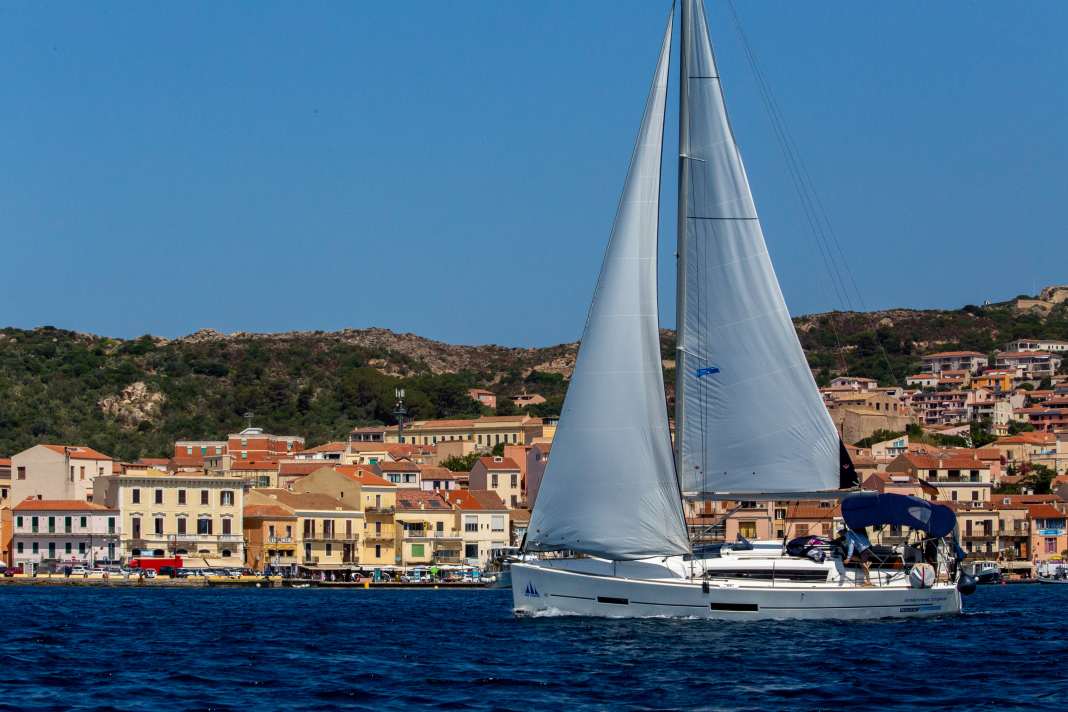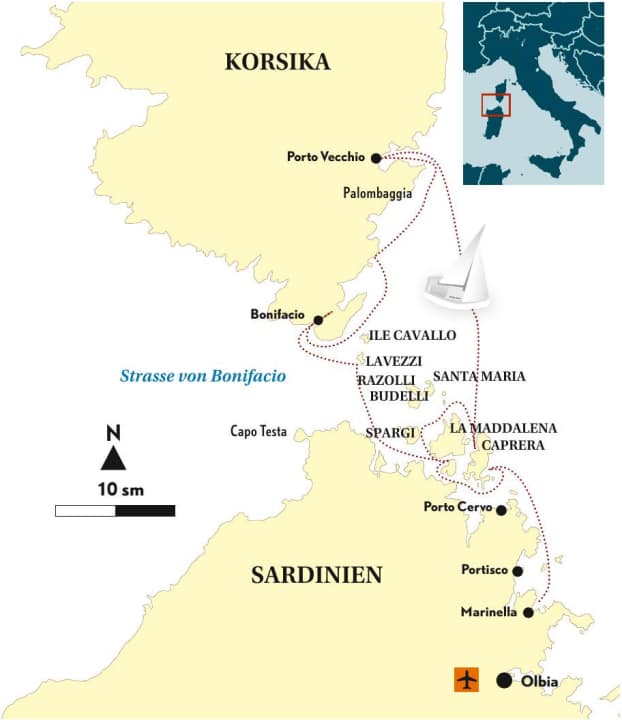





Click here for part 1 of the travelogue: Sardinia's dream bays
We approach the entrance to Bonifacio: first you can't see the narrow gap in the steep rock for a long time, then you thread your way between the light grey, vertically towering rocks. We know from experience: The harbour at the end of an almost embrasure-like bay is full and we have to call in by radio. But as soon as I get on the radio, I can already hear the yachts in front of us cancelling their reservations.
And then the entrance to Bonifacio: first you can't see the narrow gap in the steep rock for a long time, then you thread your way between the light grey, vertically towering rocks. We know from experience: The harbour at the end of an almost embrasure-like bay is full and we have to call in by radio. But as soon as I get on the radio, I can already hear the yachts in front of us cancelling their reservations.
Special berths
You should have booked a day in advance. The first ones are already steaming out again. But we try the Calanque de la Catena. A steep rocky bay that branches off at right angles from the main bay to the north. The harbour authority has laid out mooring lines on rings in the rock. Everything is very narrow, the mistral blows in gustily around the corner, across to the moorings. A single place at the very back seems to be just right. We need two attempts, but then the dinghy crew takes the stern line over, attaches it to the rock and the German berth neighbours help hand over the mooring line for the bow. Despite the bow thruster, it is pushed away so quickly that only energetic steaming into the windward stern line can hold the yacht against the wind until the mooring line is secured to the bow. Phew. After this challenging manoeuvre, we have a Corsican thank-you chestnut beer for the neighbours - and us. "You're the third people to have tried it, the others have all been forced off after several failed attempts," they say with a grin.
Oh, so the sailing day really ends on a doubly fine note. In the evening, we head to the city harbour by dinghy, a semi-sinker thanks to four men. Megayacht after megayacht are moored side by side here, a spectacle of wealth. Up the steep footpath into the town, and you find yourself in Bonifacio's beautiful, winding old town centre. Pretty bars, cafés, restaurants and small shops in between.
Bonifacio towers 60 metres above the sea
The old town has always been a coveted, contested fortress in the Mediterranean. High up on the rock, it was difficult to conquer and was often besieged. The founders therefore built an ingenious supply system for the rare drinking water: when the houses were built, large cisterns were constructed underneath, which collected the rainwater from the roofs via an ingenious system of pipes and mini-aqueducts, making it possible to survive long sieges even in summer.
The narrow alleyways provide shade. The village is a little gem and the spectacular approach is an experience. We round off the perfect day in a Corsican restaurant institution: The "U Castille" (book in advance! Tel.: +33/495/730499) offers original and good Corsican cuisine, from wild boar to the best fish dishes. If you can get a seat with a view of the sea, you are practically sitting on the rock face with a sea view.
On the way back to the harbour at night, the view down from the fortress rewards you with a spectacle: colourfully illuminated, the mega yachts and their lights lie at the foot of the mountain. Another spectacle. And the first morning in France begins in true Francophile style: the finest, delicate croissants, crusty baguettes from the bakery, a café au lait on the pier. The other, French side of the Strait of Bonifacio. Savoir-vivre at its best, you simply have to love it.
Around the Southern Cape with a tailwind
As the mistral was just catching its breath yesterday and is due to really get going this afternoon, we decide to head for the front: with the mistral behind us, we sail around the southern cape of Corsica on the east coast of the island, sheltered from the lee, up to the second island town in the south, Porto-Vecchio. No waves, half wind, plenty of anchorages on the way. Sounds good. And it does: the Dufour gets wings, and with the wind getting stronger and stronger, we fly the ten miles around the cape. Pure sailing fun.
But instead of passing through, one of Corsica's most beautiful anchorages beckons: Rondinara. A semi-circular bay, perfectly sheltered from the mistral, with a great beach bar, the finest sand and plenty of space for anchoring and swimming. We can't resist. Another one of those flawless spots. The area really does have a top destination every five miles. As soon as the boat is anchored, fellow sailor Marc sweeps through the bay with his kite, we watch, the risotto is already simmering below deck. Afterwards, we head to the beach bar for a café gourmand (you'll be surprised ...) and a sundowner. How many more perfect sailing days are we going to have?
Porto-Vecchio: pure Corsica
The drive to Porto-Vecchio the next day is just a stone's throw away. Another uniquely beautiful town high up on a green mountainside, with the high mountains of Corsica already visible in the background. Everything is a little smaller and more tranquil than in Bonifacio, but no less beautiful. Here a façade overgrown with wild vines, the church in the town with original, painted ornaments on the ceiling - there is always a little highlight.
If you want to buy the Corsican speciality wild boar sausage or the famous spicy sheep's cheese, you've come to the right place. With the famous, beautifully crafted Corsican pocket knives, the whole thing can be cut up in style in the cockpit in the evening. There is also a proper marina with plenty of space without having to worry about booking. There are far fewer crews sailing to Porto-Vecchio.
The Maddalena Archipelago: beauty off the coast of Sardinia
We don't want to leave, but the week is short, so we head back to Italy, as the mistral is due to subside tomorrow. And again these painfully beautiful bays. This time on the north-east side of Maddalena, Cala Garibaldi, with the abandoned Club Med up on the ridge. A small forest lines the beach on the shore and boats are moored in a narrow channel. A calm, peaceful atmosphere hangs over the bay. There are so many of them, and in so many of them you can simply lose yourself in the heat of the day, swimming and turquoise water.
Ideal for the night, beautiful, but we want to finish off at Cala Gavetta, the main harbour on the island of Maddalena, which is simply part of a cruise in the area. It's just too beautiful between the pastel-coloured houses. There are cosy bars and restaurants around the busy harbour basin (best to book in the morning, tel.: +39/0789/790624). And above all, probably the best ice cream parlour on the island, the gelateria "La Finestrella", with an old lady in a bright red headscarf as the shop assistant. Followed by freshly caught fish and, of course, Vermentino, Sardinia's famous dry white wine. A detour to the best gastro speciality shop on the island, "Miro dal 1891" in Via Italia, is also a must on the fifth trip.
Fine hams hang from the ceiling as if on parade, there is the Sardinian bread pane carasau, sensational mortadella and simply everything that northern Europeans love about Italian cuisine. Anyone who leaves here without a souvenir for those at home is beyond help. Italy like in a picture book.
A blessing at the end
So we end up happily at the restaurant in the evening. In front of our tables, a church procession with a chapel suddenly pulls up to the harbour. There they stop in front of a beautiful wooden ship in the style of the old Sardinian Latin fishing boats, the "Leonidas". The Pope goes on board, invokes the Lord in song and gracefully blesses the ship and the two-man crew, sings a few hymns at the top of his voice in beautiful Latin, and the procession of the faithful moves on.
We want to know what that was from the skipper. He is a young boat builder who built the 13 metre long wooden boat himself a few years ago and now charters and skippers it as a day trip boat. "The priest blesses us every year after the procession so that we always find our way safely back to the harbour." Oh, Italy, you just have to love it. Just like France. It's nice to be able to experience the best of two worlds in one week.

Precinct information:
Journey: Flights to Olbia from many German departure airports. Prices from around 350-400 euros, depending on the season. Transfer to the charter base in Marina dell'Isola approx. 30 minutes. It is best to book through the base, as taxis are sometimes difficult to get at short notice on Saturdays during the season.
Charter: We were travelling with an eight-year-old Dufour 38 from the German charter company Sun Charter. The boat was technically flawless. The fleet is a mixture of Bavarias, Sun Odysseys, Dufours and some Lagoon and Nautitech cats. A two-year-old Bavaria 37 costs 2,970 euros if booked before the turn of the year with an early booking discount of 20 per cent in June. The base in Marina dell'Isola is a beautiful facility in a quiet bay, with a café, beach, bathing area and nearby restaurants. Probably the most beautiful base in the area! Bookable via: Sun Charter, www.suncharter.deTel.: 08171/29905 or info@suncharter.de
The precinct: There are numerous shallows and rocks in the area that must be taken into account. Time and again, crews run aground, especially under autopilot or when making short runs into the next bay. Our actually booked, one-week-old Bavaria 46 had to go to the boatyard right before our start! Careful planning and chart/plotter work are therefore a must. Please note the national parks of the Maddalena Islands on the Italian side (lamaddalenapark.it) and that of the Lavezzias in French. Crews must register online for the duration of the trip and pay the national park fee before entering the Italian park. The area is strictly zoned, the map is available as a download, and anchoring and navigation bans apply in some areas. Important: In most zones, a distance of 300 metres from the shore must be maintained, it is forbidden to deploy land lines or similar, and there are also controls. Anchoring on seaweed is strictly prohibited here and on the French Lavezzis!
Wind & weather: Between Corsica and Sardinia, the Strait of Bonifacio forms a narrow channel that creates a wind nozzle in strong winds from north-west to west or east. If the mistral threatens, it blows quickly at 6 to 8 Beaufort and the sea is correspondingly rough. The route to Bonifacio is then not recommended. The French weather service has the best mistral forecasts meteofrance.com.
Harbours & anchorages: On the coast of Sardinia there are various larger marinas with good facilities and service. However, most crews stay on the islands. La Maddalena with Cala Gaveta and the floating dock Marina Cala Mangiavolpe is a good stop there. In Corsica's south, Bonifacio and Porto-Vecchio. The choice of bays is huge, you can almost always find a place. There are often buoys available for a fee and cashiers come around with the RIB.
Literature & nautical charts: Klaus-Jürgen Röhring: Corsica, Sardinia Elba, Delius Klasing, 39,90 Euro. ISBN: 978-3-667-12585-9

